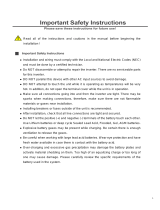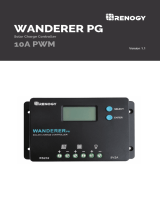
— 20 —
Solar Panel Safety
zDo not use the solar panel(s) if there is any damage.
zPrior to connecting the inverter charger to the solar panel(s), shade the solar panel(s).
Grid or AC Generator Safety
zRisk of electrical shock! Ensure the grid or the AC generator is turned o before connecting them to the inverter charger.
zThe inverter charger can only be connected to 120V single-phase power systems through the AC Input Port. Otherwise,
the inverter charger will be damaged.
Renogy Support
To discuss inaccuracies or omissions in this quick guide or user manual, visit or contact us at:
renogy.com/support/downloads contentservice@renogy.com
To explore more possibilities of solar systems, visit Renogy Learning Center at:
renogy.com/learning-center
For technical questions about your product in the U.S., contact the Renogy technical support team through:
renogy.com/contact-us 1(909)2877111
For technical support outside the U.S., visit the local website below:
Canada ca.renogy.com China www.renogy.cn
United Kingdom
uk.renogy.com Australia au.renogy.com
South Korea kr.renogy.com Japan renogy.jp
Germany de.renogy.com Other Europe eu.renogy.com
FCC Statement
This device complies with Part 15 of the FCC Rules. Operation is subject to the following two conditions:
(1) This device may not cause harmful interference.
(2) This device must accept any interference received, including interference that may cause undesired operation.
Any Changes or modifications not expressly approved by the party responsible for compliance could void the user’s
authority to operate the equipment.
This equipment has been tested and found to comply with the limits for a Class B digital device, pursuant to Part 15 of
the FCC Rules. These limits are designed to provide reasonable protection against harmful interference in a residential
installation. This equipment generates, uses and can radiate radio frequency energy and, if not installed and used in
accordance with the instructions, may cause harmful interference to radio communications. However, there is no guarantee
that interference will not occur in a particular installation. If this equipment does cause harmful interference to radio or
television reception, which can be determined by turning the equipment o and on, the user is encouraged to try to correct
the interference by one or more of the following measures:
(1) Reorient or relocate the receiving antenna.
(2) Increase the separation between the equipment and receiver.
(3) Connect the equipment into an outlet on a circuit dierent from that to which the receiver is connected.
(4) Consult the dealer or an experienced radio / TV technician for help.
FCC Radiation Exposure Statement
This equipment complies with FCC radiation exposure limits set forth for an uncontrolled environment. This equipment
should be installed and operated with minimum distance 20 cm between the radiator & your body.
RENOGY.COM
Renogy aims to empower people around the world through education and distribution of DIY-friendly renewable
energy solutions.
Renogy Power Plus allows you to stay in the loop with upcoming solar energy innovations, share your experiences
with your solar energy journey, and connect with like-minded people who are changing the world in the Renogy
Power Plus community.
We intend to be a driving force for sustainable living and energy independence.
In support of this eort, our range of solar products makes it possible for you to minimize your carbon footprint
by reducing the need for grid power.
Renogy Empowered
Live Sustainably with Renogy
Did you know? In a given month, a 1kW solar energy system will...
Save 170 pounds of coal from being burned
Save 300 pounds of CO from being released into the atmosphere
Save 105 gallons of water from being consumed
@Renogy Solar @Renogy@renogyoicial
Renogy Power PLUS
Renogy reserves the right to change the contents of this quick guide without notice.
5021988
FCC ID : 2ANPB-RIV4835PCS








